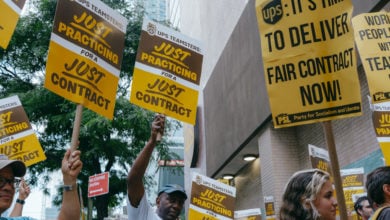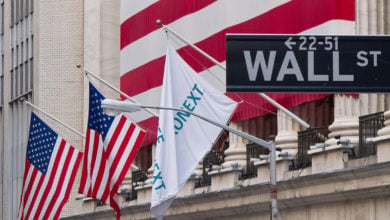 Bush meets with friend and financial backer, former Enron CEO Kenneth Lay, in 2001. Photo: Reuters/Jeff Mitchell |
On May 23, Kenneth Lay and Jeffrey Skilling—former CEOs of the infamous Enron Corporation—were convicted of crimes against their economic class. Lay and Skilling are scheduled to return to court in September to be sentenced for numerous counts of fraud involving billions of dollars. Unlike countless working class defendants convicted of stealing just a few hundred dollars, the corporate crime bosses remain free on bond.
Before their recent misfortunes, Enron and Lay in particular had many friends in high places. Enron was the single biggest campaign contributor when George W. Bush ran for governor of Texas in 1994.
In January 2001, in the midst of the California energy crisis for which Enron bore considerable responsibility, Lay spent a lot of time with the newly inaugurated Bush administration. Lay was part of Vice President Cheney’s energy task force. Some speculated that “Kenny Boy”—as Bush nicknamed Lay—would be named secretary of energy.
But Enron did not limit its contributions to Republicans. It provided hundreds of thousands of dollars to former president Clinton and the Democrats too. In return, both the Clinton and Bush II administrations lobbied on Enron’s behalf domestically and internationally.
Lay and Skilling were not found guilty of their real crimes: destroying the retirement plans of thousands of Enron employees, gouging billions of dollars in utility charges from California residents, looting Third World countries and more. They were not found guilty because they were never charged for those devastating acts.
Under the capitalist “justice” system, cheating workers and consumers is not generally regarded as a crime at all. The courts, for example, regularly allow companies to ditch their employees’ pension plans.
Pensions are deferred wages. Refusing to pay a negotiated or promised pension should be seen as the same as refusing to pay wages—a crime. When a corporation goes bankrupt—as Enron did—the unpaid workers go to the bottom of the creditors’ line, which usually means that they get nothing.
Defrauding the big banks and financiers is another matter. That’s a punishable crime. Of course, the ruling elite has never been horrified by a little fraud and deception. They all do it. But when it runs into the tens of billions dollars, and threatens to bankrupt or pull down other large financial institutions, that is altogether different.
Corporate America has not always been down on Enron. Fortune Magazine, a leading business publication, named Enron the “most innovative company in corporate America” for 6 years in a row, 1995-2000. The following year—after having risen to seventh on the list of Fortune’s 500 largest corporations—Enron collapsed. A little too much “innovation” was going on, it turned out.
In fact, Enron was mainly “innovation.” It produced little real value, specializing in unbridled speculation. With more than 20,000 employees in 1999, Enron was probably the biggest middleman in history. From an objective point of view, it was a parasitic enterprise, producing nothing but great wealth for a few people, at the expense of millions.
 Workers in California protest the electricity corporations’ market manipulations, January 2001. Photo: Bill Hackwell |
Under a rational economic system, there would be neither a need nor a place for a company like Enron.
Enron traded in more than 800 commodities and concepts, everything from lumber and steel, to bandwidth and “weather risk management.” But its biggest and most profitable undertakings were in the field of energy. Enron has since become notorious for its astoundingly profitable manipulation of the electricity market.
A high-tech gold rush
In the wake of a bipartisan 1996 state law deregulating electricity, Enron and a number of other energy companies and speculators charged into California. It was like a high tech version of the Gold Rush of 150 years earlier.
Utility monopolies and energy capitalists argued that deregulation would give California residents and businesses the “freedom” to select the power company of their choice.
What good this “freedom” could possibly do for a renter or homeowner was not addressed by the corporate politicians. Nor did they state why California’s three giant utility monopolies—Southern California Edison, Pacific Gas & Electric and San Diego Gas & Electric—would want to free their captive markets.
For one, the state legislature agreed to impose a “competition tax” to freeze residential and small business electricity rates for four years at 50 percent above the national average. By 2000, consumers had paid $9.3 billion to So. Cal. Edison alone under this tax.
As part of deregulation, the big utilities began to sell off their generating plants. The plants were purchased by about a dozen power companies, the biggest of which included Enron, Duke Energy, Reliant, Southern Energy and Dynergy.
Under the new “free market” created by deregulation, the stage was set for the most blatant forms of manipulation. They were not long in coming.
Taped conversations are widely available of an Enron trader urging a power plant operator in Las Vegas to “unexpectedly” take his plant off-line that night in order to create a supply crisis the next day. This would allow the electricity brokers to wildly inflate their prices.
The next day, Jan. 17, hundreds of thousands of people suffered artificially caused power outages across the state, causing then California governor Gray Davis to declare a state of emergency.
Taking plants off-line was just one of countless manipulations that caused the cost of energy to skyrocket in California in 2000 and 2001. In other taped phone calls, Enron traders are heard cynically joking about squeezing the elderly to enrich themselves.
By the end of 2000, market manipulation had caused the price of electricity to soar to unbelievable levels. At certain hours, electricity brokers were purchasing a megawatt of electricity—which cost $45 the previous year—for as much as $1,400. That is a 3,000 percent increase in cost, all of which was passed down to the customer.
As the people of California suffered, Enron’s stated annual profit tripled. And they were not alone. Other energy brokers saw profit increases of 500 to 800 percent.
‘Off shoring’ the debt
As Enron reaped enormous new profits in California, the company suffered heavy losses in its speculation businesses. Due to its lavish payouts to executives and shareholders, Enron—like the high-tech and energy sector in general—also took a hit from the economic recession of 2000-2001, which saw sharp drops in the price of oil.
By late 1999, Enron’s stock was selling for $90 per share. Over the next two years, until declaring bankruptcy in 2001, Enron executives like Lay, Skilling, Andrew Fastow and others oversaw a tangled web of schemes designed to keep the stock price high, despite mounting losses.
The Enron executives created fake companies, sometimes in other countries, to buy pieces of Enron’s debt, which on paper would be converted into revenue. But the fake companies were all completely under Enron’s control.
In this way, Enron executives were able to slow, but not stop, the slide in Enron’s stock price, and delay the banks, pension funds and other investors from a panicked sell-off of their shares.
While Lay and his cohorts continued to declare through 2001 that everything was fine, they sold off their own Enron stock. In e-mails and speeches to company employees, he claimed that he was actually buying more stock. It was later revealed that in 2001, Lay bought $4 million of the stock but sold $24 million.
At the beginning of 2001, Enron’s stock was selling for $80 per share and Lay was spending a lot of time at the White House. By the end of the year, the company was bankrupt and the stock was selling for only 30 cents.
The total monetary loss exceeded $60 billion, sustained primarily by big investors and pension funds, many of them state and city funds.
This is what drew the wrath of the capitalist ruling class, and caused Lay and Skilling’s convictions. They tricked and defrauded the big investors.
The executives were not questioned at all about the California energy crisis, which hurt millions. In fact, the California crisis was made explicitly off-limits in the trial.
Pensions destroyed
While Lay was the financial rat deserting the sinking ship—though still reaping enormous profits even as it went down—the average Enron worker was left to drown.
Most of the 401(k) retirement funds held by Enron employees were composed of Enron stock. Even as they were quietly selling their private stock, Lay and Skilling kept urging Enron employees to buy more stock.
Of course, many employees saw that crisis, or at the very least difficulties, were on the horizon. With stock prices steadily declining in 2001, employees wanted to sell their stock.
But they could not. Company policy prevented anyone under the age of 54 from selling their stock. So while the rich got even richer in the last days of Enron, the employees suffered catastrophe.
Someone who had worked at Enron for 15 years, and held $100,000 worth of company stock at the end of 2000, would have seen that amount reduced to less than $800 a year later.
On top of that, they were out of a job. Many of those employees, especially the older ones, had little or no likelihood of finding comparable employment. And their retirement fund was gone. Because 401(k) plans are “defined contribution” plans, rather than pension plans in the official sense, the federal Pension Benefit Guarantee Corporation is offering no help whatsoever to the former Enron workers.
Enron still exists as a smaller company. It has emerged from bankruptcy and is making partial repayments to some of its corporate and banking creditors. But it is doing nothing for the thousands of workers whose jobs and retirements it destroyed. Until that happens —no matter what kind of jail time Lay, Skilling and their fellow pirates get—justice will not be served.
Articles may be reprinted with credit to Socialism and Liberation magazine.






